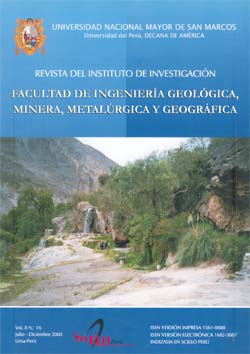Physicochemical characterization and metallurgical tests in the prospecting of polymetallic minerals in the Marañón-Peru Complex
DOI:
https://doi.org/10.15381/iigeo.v8i16.708Keywords:
Characterization, Geological Prospection, Marañón Complex, MetallurgyAbstract
Prospective studies developed in the zone of the Marañón basin show us a type of regional geology called the Marañón-Huánuco Region Complex, consisting of metallic minerals of Copper, Silver, Gold in schists and gneiss in contact with intrusives, as well as minerals of nickel, cobalt, titanium, platinum, among others. The characterization of the minerals in the area using instrumental techniques: minerographic microscope, Mössbauer spectroscopy analysis, multielemental chemical analysis, allow us to corroborate the presence of the metallic minerals of the Marañón Complex, as well as the presence of iron oxides, and to a degree of magnetization that are indicators of the metallic presence in the sampled areas. Metallurgical tests carried out indicate a good metallurgical recovery of the concentrates obtained for the chalcopyrite ore, which indicates a good economic possibility for the Marañón basin.
Downloads
Published
Issue
Section
License
Copyright (c) 2005 Daniel Lovera, Ángel Bustamante, Pedro Gagliuffi, Janet Quiñones, Luis Puente, Laureano Gaudencio, Jorge Diego, Alfonso Romero

This work is licensed under a Creative Commons Attribution-NonCommercial-ShareAlike 4.0 International License.
AUTHORS RETAIN THEIR RIGHTS:
a. Authors retain their trade mark rights and patent, and also on any process or procedure described in the article.
b. Authors retain their right to share, copy, distribute, perform and publicly communicate their article (eg, to place their article in an institutional repository or publish it in a book), with an acknowledgment of its initial publication in the Rev. Inst. investig. Fac. minas metal cienc. geogr.
c. Authors retain theirs right to make a subsequent publication of their work, to use the article or any part thereof (eg a compilation of his papers, lecture notes, thesis, or a book), always indicating the source of publication (the originator of the work, journal, volume, number and date).






